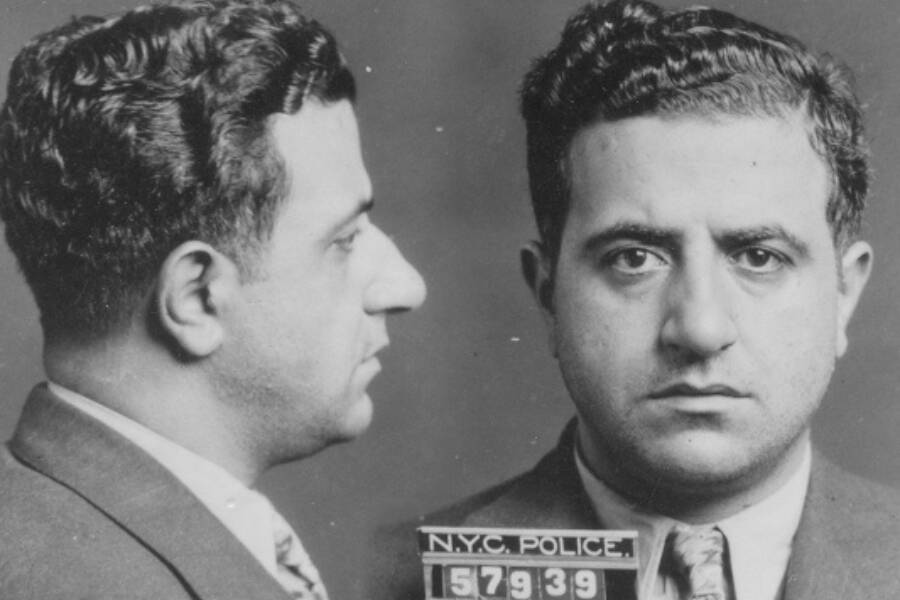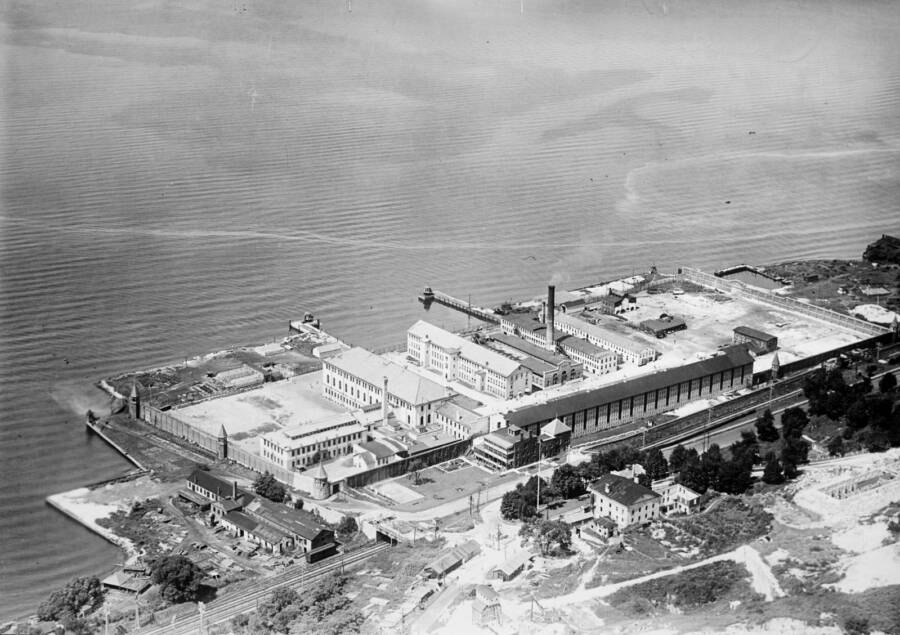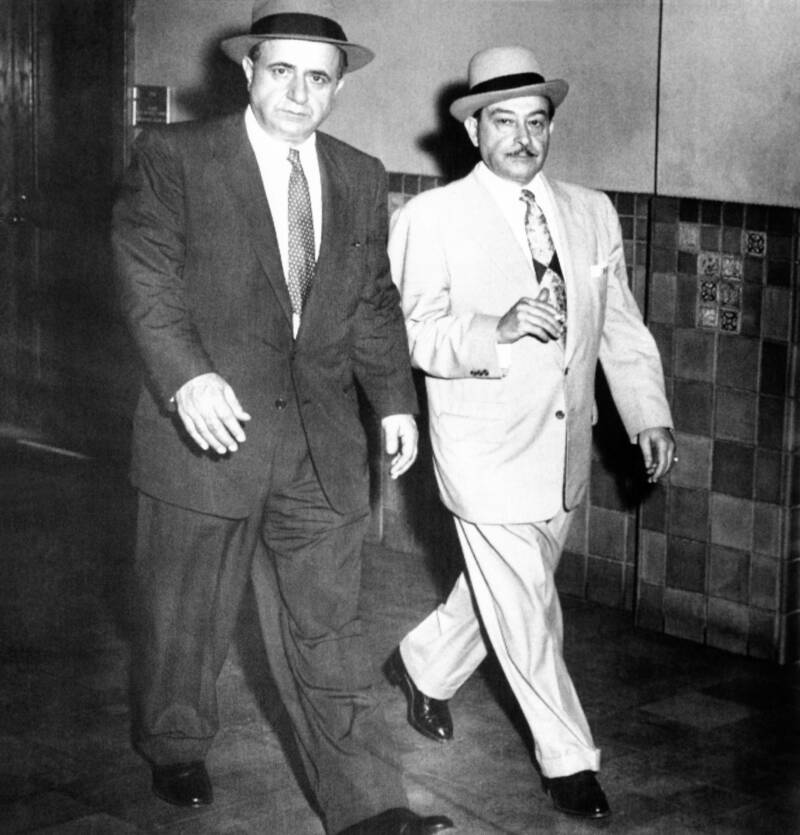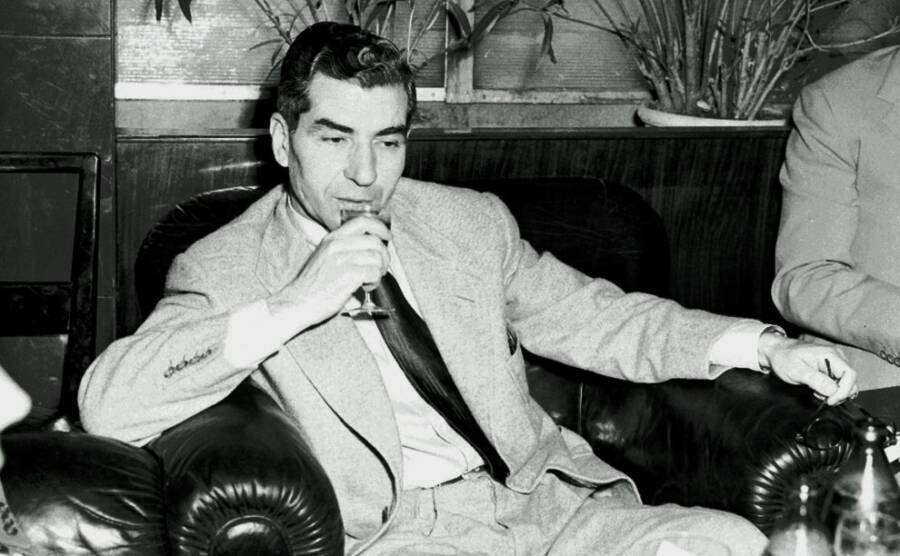The co-founder of Murder, Inc. and the head of the infamous Mangano family, Albert Anastasia was one of New York City’s most feared gangsters — until his story came to an end in shocking fashion.

Wikimedia CommonsAlbert Anastasia, the man behind Murder, Inc.
The Greek word anastasis literally means “rising up.” It’s a fitting root for the name of Albert Anastasia, who went from a poor, fatherless boy in Italy to New York’s most feared gangster — a man so bloodthirsty that he was called the “Lord High Executioner.”
Not only did Albert Anastasia help found the modern American Mafia, he also co-founded and later took charge of Murder, Inc., the enforcement arm of the National Crime Syndicate. In short, Albert Anastasia was a killer — and a cold-blooded one at that.
He was known for his ruthlessness above all else, and his name was equal parts feared and respected. Unfortunately, the danger he presented also led to his downfall and eventual murder in a barber shop at the Park Sheraton Hotel in Midtown Manhattan.
His death became the focal point of a high-profile police investigation. But while Vito Genovese and Carlo Gambino purportedly ordered the attack, police never caught Anastasia’s killers.
After all, Anastasia had countless enemies. Mobsters like Joe Gallo even boasted about their role in the killing, saying, “You can just call the five of us the barbershop quintet.”
How A Young Italian Immigrant Became Albert Anastasia
Albert Anastasia was born Umberto Anastasio in Calabria, Italy in 1902. His father, a railroad worker, died shortly before World War I, leaving Albert’s mother to look after twelve young children.
It was a bleak period, and the family struggled to make ends meet. Eventually, it became clear that the older children would need to strike out in search of work elsewhere.
So at the age of fifteen, Anastasia took a job on an Italian freighter, alongside some his brothers. When their ship docked at the Brooklyn waterfront, the Anastasio boys slipped quietly away, leaving Italy behind for a new land — a land of opportunity.

colaimages / Alamy Stock PhotoAlbert Anastasia (second from right) with his brothers and nephew.
But with opportunity came danger. The boys found work as longshoremen on the very docks they had arrived at and plunged into the seedy underbelly of the shipping industry, where the mob all but controlled daily operations.
Anastasia’s first run-in with the law came in the spring of 1921, when he became embroiled in a quarrel with fellow dockworker George Turino. The disagreement turned violent, and Anastasia ended up killing Turino.
For the murder, the young Anastasia was arrested and sentenced to death. It was around this time, cooling his heels in Sing Sing Correctional Facility, that he changed his name from Umberto Anastasio to Albert Anastasia — to spare his relations the shame of having a criminal in the family, his brother would later tell the New York Times.
And there, from his lowest point, the newly christened Albert Anastasia began to rise.
Escape From Death Row
Accounts of what happened next differ.
Some say Albert Anastasia’s cool demeanor and aptitude for violence attracted the attention of Jimmy “the Shiv” DeStefano, the “Death House Barber” of Sing Sing.

Wikimedia CommonsAn aerial view of the Sing Sing prison in Ossining, New York, in 1920.
DeStefano sent word to up-and-coming mob boss Lucky Luciano, who was reportedly chaffing against the conservative notions of the old Mafia — namely, that initiates should be Sicilian and have a strong resume of criminal enterprises in Italy before joining up in the U.S.
Luciano seems to have taken an interest — though it’s unclear whether luck or Luciano did the most to save Albert Anastasia from an early grave.
One year into Anastasia’s prison stay, his lawyer managed to get him a retrial. By the time Anastasia showed up in court again, four of the prosecution’s witnesses had mysteriously disappeared. He won the case on a legal technicality.
Albert Anastasia was free again.
Albert Anastasia’s Violent Rise To Power
Though he’d narrowly escaped death, Albert Anastasia had developed a taste for living outside the law. He quickly became a prominent leader in the International Longshoremen’s Association, a hub for racketeering and murder.
He went to prison again in 1923 for illegal possession of a firearm. And when he emerged two years later, it was to make his debut in Brooklyn’s Mafia under the aegis of “Joe the Boss” Masseria.

Everett Collection Historical / Alamy Stock PhotoAlbert Anastasia (left) leaving Federal District Court with his attorney, Anthony Colendra.
But his loyalty, it soon became clear, was to Lucky Luciano, who was planning to overthrow the old order and start a more inclusive criminal enterprise — one that could partner with the Jewish and Irish syndicates for larger-scale operations.
Anastasia presented himself to Luciano as muscle, an assassin who could ensure his rise to the top.
He proved his worth in 1931, when Luciano lured Masseria to a restaurant. Anastasia, accompanied by several associates, entered the restaurant and gunned down the famous mob leader, ending his reign and making room for a new generation of Mafiosos.
And Anastasia was determined to play an important role in the new world order.
The Founding Of Murder Inc., The Mob’s Deadliest Enforcers
In the bloody decade that followed, Anastasia rose through the ranks of the Mafia by making his name synonymous with murder.
In 1932 and 1933, he was indicted twice on murder charges. But each time, he escaped conviction when witnesses melted away, unwilling to testify.

Wikimedia CommonsCharles “Lucky” Luciano, an Italian mobster born in Sicily, is considered the father of modern organized crime in the United States for his reorganization of the five Mafia families and establishment of the Commission.
As a reward for Anastasia’s services, Luciano, now the most powerful man in the American Mafia, tapped him to help lead up Murder, Inc., the enforcement wing of the National Crime Syndicate.
With Luciano’s support, Anastasia also became underboss of the Mangano crime family, which would, in time, become the notorious Gambino clan.
As others fell around him — Luciano was arrested, the members of Murder, Inc. were prosecuted, and a number of prominent mobsters fled to Italy — Anastasia remained.
Meanwhile, the men who could tattle on him — most notably, Abe Reles, the Murder, Inc., hitman who flipped to save himself from execution — died in mysterious accidents.

Wikimedia CommonsAbe Reles, Murder, Inc. hitman and ill-fated police informant.
In time, Vincent Mangano and his brother were murdered. Though many eyes turned to Anastasia, he was never convicted.
Instead, he assumed Mangano’s role as boss.
The Luxurious Mansion With A Dark Underbelly
Albert Anastasia had reached heights nearly unimaginable for a poor railman’s son.
By the late 1940s, he lorded over an enormous estate in Fort Lee, New Jersey. The stucco-and-tile mansion boasted sprawling views of New York while maintaining some distance: a peaceful urban oasis.
Like the man, the mansion had a hidden dark side — false walls, rumored tunnels, and ominous basement rooms with drains in the floor for slaughtering “deer.”
As reported in Allan R. May’s book Gangland Gotham: New York’s Notorious Mob Bosses, Albert’s son, Umberto Jr., once warned reporters not to stand too close to the estate’s fences: “Don’t put your foot in here, the dogs will bite it off.”

colaimages / Alamy Stock PhotoMobster Albert Anastasia with his family in the 1940s.
Trouble On The Horizon
Albert Anastasia’s good fortune came to an abrupt end in 1952, when he was targeted by the government for denaturalization for lying in his naturalization application, as well for other sundry crimes and misdemeanors.
Like fellow gangster Al Capone, he was even charged with tax evasion. Exhibit A was a mockup and blueprints of his sprawling estate, incriminating the man who claimed no income for years.
While he was battling it out in court, the Genovese crime family began to plot against him, cozying up to Anastasia’s capo, Carlo Gambino.
The tide was finally turning against him. But Anastasia, caught up in his own troubles and confident in his control, missed the warning signs.
The Bloody Fall Of Albert Anastasia, The Mob’s Lord High Executioner
On Oct. 25, 1957, Albert Anastasia was chauffeured from his cliffside home into the city to visit his barber at the Park Sheraton Hotel in Manhattan. His bodyguard left to run a quick errand, leaving the mobster momentarily unprotected.
As Anastasia sat facing the mirror, two masked assassins stormed into the shop and fired ten shots at the stunned mob boss. Confused and disoriented, he attempted to rush his killers but ended up charging at their reflections instead. Anastasia fell to the floor in a heap, dead.

George Silk/The LIFE Picture Collection/Getty ImagesThe body of Albert Anastasia in the barbershop of the Park Sheraton Hotel, riddled with bullets.
His assailants disappeared into the city. They were never identified, and while many have pointed the finger at Vito Genovese and Carlo Gambino, to this day it’s unclear who ordered and carried out the mob hit.
The image of Anastasia’s lifeless body, covered in towels on the barbershop floor, stunned the public. The brutal murder became iconic in mob history, a shorthand for the violent interfamily wars of the 1950s.
Anastasia’s death marked the end of a nearly 30-year reign that made him one of the deadliest criminals in U.S. history. Today, his legacy lives on in the Gambino crime family, who rose to prominence as one of the most powerful crime syndicates in the country on his bloody shoulders.
After learning about Albert Anastasia, learn about the Apalachin meeting after his death, which contributed to the decline of the Mafia. Then, meet some of the Mafia’s most deadly hitmen.





